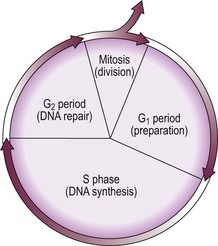27 The life cycle of the normal cell is shown schematically in Figure 27.1. Conventional anti-leukaemic and lymphoma cytotoxic drugs can be broadly divided into those agents active during only one phase of the cell cycle (‘phase-specific’) and those acting at all stages (‘phase non-specific’). In practice, most anti-leukaemic drugs act predominantly against proliferating cells and therefore affect a fraction of the malignant cell population. Thus, if in advanced acute leukaemia the total number of malignant cells is 1010, a single course of chemotherapy could be expected to kill between 2 and 5 log of cells, leaving between 105 and 108 residual leukaemic cells. It can be seen that the chance of eradication of the disease by chemotherapy is favoured by early treatment when the leukaemic mass is small and by repeated courses of cytotoxic drugs. It is also logical to combine different agents to maximise the anti-leukaemic activity and exploit different toxicities (‘combination chemotherapy’).
Chemotherapy and related treatments
General principles
Major classes of conventional cytotoxic drugs
Oncohema Key
Fastest Oncology & Hematology Insight Engine




